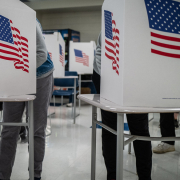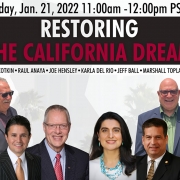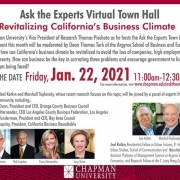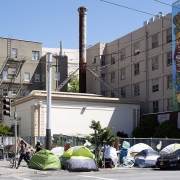The Election: An Old Picture Changes
For much of modern American history, the support enjoyed by the two main political parties has hewed to a particular ethnic pattern. Republicans, notes political historian Michael Barone, have largely been the party of “white Protestants,” while the Democrats have been largely “a coalition” of disparate groups: Catholic ethnics, Latinos, blacks, Jews, and working people of all races.
Today that paradigm is shattering. The Democrats have morphed into the political party dominated by the professional classes, the federal bureaucracy, and those dependent on government transfers. The Republican Party, well before Donald Trump and particularly under Richard Nixon and Ronald Reagan, had been gaining ground among white “ethnic” working-class voters who were once Democrats. But now the GOP is making headway with other ethnic groups, winning a significantly larger portion of the Latino vote, particularly in Florida and Texas, in 2020. Republicans also show signs of building support among Jews, who largely rejected Trump in 2016, and perhaps Asians and African Americans.
Of course, all these groups will still likely vote more for Democrats than Republicans this year, but any serious erosion in the Democrats’ traditional ethnic base could prove catastrophic for them because Republicans, notes Pew, enjoy a strong majority among whites. Many conservatives may fret about the political effect of ethnic change giving Democrats a permanent majority, but ethnic politics are clearly changing. To win over the long run, Republicans must cleave off enough minority voters as the U.S. moves towards becoming a majority-minority country by mid century.
Economic Roots
These shifts primarily (although not solely) reflect economic changes. Certain classes are doing better, as the ranks of those working in the professions — at least until the full impact of artificial intelligence — continue to grow. Most employment growth is now concentrated in government and largely publicly funded health care, as well as low-wage service jobs. In contrast, many traditional small businesses are having to contend with an increasing regulatory burden. Overall one in four Americans fear losing their job in the next year.
The current economic divide between the professional urban class and most Americans of any race is enormous. These elites are thriving economically, but the working class is doing less well, and are far less supportive of Joe Biden. Recent polling suggests that even young people are shifting away from the president, who won their votes easily in 2020, and towards Trump. Media accounts may link this to the Gaza war, but polling shows that when asked what concerns them most young people say economic issues by a wide margin.
Latinos
Minorities make up over 40 percent of the nation’s working class and by 2032 will constitute its majority. Latinos are (taken as a whole) the largest single group within this category, and by 2050 their numbers are expected to account for 30 percent of the overall population, more than twice the black share. Latinos, of course, vary by class and heritage. Some, such as Puerto Ricans, remain overwhelmingly Democratic, while Cubans veer to the GOP. Mexicans, the largest group, are often divided by class and degree of religious commitment, whether Catholic or evangelical.
Republican support among Hispanic voters has grown by ten points since 2018, and Trump now polls close to even. In recent elections, Barack Obama, Hillary Clinton, and Joe Biden won roughly 70 percent of the Latino vote. Currently, it seems likely Trump will do better in 2024, helped by the Democrats’ sharp turn toward cultural progressivism, which is at odds with the more conservative social views held by many Latinos.
But economics are also likely to push Latinos towards the Republicans. Concerns about competition with newly arrived immigrant low-wage labor and fears of crime are leading more Latinos to favor stronger border restrictions. Forty-five percent, according to one April poll, even favor mass deportations. These sentiments are most common in areas such as south Texas, a formerly strongly Democratic area that has shifted towards the GOP, where most Hispanics, according to one survey, favor Governor Abbott’s anti-migration agenda over the Biden administration’s border approach.
At the same time, the current influx of largely poor, barely educated immigrants forces less skilled immigrants to compete with already struggling working-class citizens; the Congressional Budget Office warns that the recent “surge in immigration,” much of it undocumented, could lower average wages, since many of the new workers are low-skilled. In addition, roughly half of all Latinos, notes Pew, associate the current influx with increased crime.
Democratic policies, both in Washington and states like California, are also becoming increasingly inimical to upward mobility — as symbolized by owning a house, gaining a decent income, and living in safe neighborhoods. In a recent report done by the Chapman Center for Demographics and Policy, we found that Californian Hispanics, roughly 40 percent of the state’s population, do considerably worse in terms of economic and educational achievement than their counterparts in right-leaning states such as Texas and Florida.
Latinos are particularly threatened by the climate-change polices that are now a central part of Democratic Party dogma. Latinos, notes Chapman report author Soledad Ursúa, are deeply involved with the “carbon economy,” in which energy reliability tends to be critical. According to data from the Bureau of Labor Statistics, Latino workers account for approximately 20 percent of the transportation industry’s workforce, over 22 percent of all manufacturing workers, and a third of all construction workers. According to a 2020 study from the Urban Reform Institute that I co-authored, Latino real incomes, adjusted by cost of living, are far lower in New York, Boston, Los Angeles, or San Francisco than in Atlanta, Dallas, or Phoenix.
Jews
Democrats usually win something close to 70 percent of the Jewish vote. The increasingly anti-Zionist and antisemitic character of radical progressive politics — even before the October 7 attacks — seems likely to push Jews rightwards. In California, the new social-studies curriculum categorizes all whites, including Jews and other historically discriminated against groups like Irish Catholics, as enjoying untrammeled “white privilege.”
The primarily left-wing antisemitic surge has created the basis for an enormous battle within the Democratic Party, in part directed against anti-Israel Democrats as well as Biden’s inconsistent and sometimes hostile stance on Israel. Mainstream Democratic Jews are also mobilizing to fight vehemently anti-Israel progressives, such as Representative Jamaal Bowman (N.Y.), in primary elections.
In their desire to appeal to (or at least not antagonize) voters who appear to be taking Hamas’s view of the conflict, Democrats should realize that in the U.S. there are well over twice as many Jews as Muslims. In 2020 Trump, according to some estimates, gained almost a third of the Jewish vote, a six-point increase from 2016. April 2024 Economist study saw 37 percent of Jewish voters favoring Trump. A Siena poll taken two months before suggested Trump had taken a lead among New York’s large Jewish population. Looking at swing states, Jews constitute 3 percent of Pennsylvania’s electorate, and represent significant blocs in both Arizona and Nevada.
Asians
Although less influential in politics, Asians are now the fastest growing racial group in the electorate. Like Jews, Asians have fallen under progressive attack for being too successful. Asian Americans have the highest per-capita income, lowest per-capita crime rates, and highest rates of college education of any racial group. Foreign-born workers, overwhelmingly from Asia, make up a remarkable three quarters of all of Silicon Valley’s tech workforce.
Although there is certainly poverty and increasing inequality, particularly among the elderly and recent immigrants, household income among Asians stands at over $100,000, compared to $71,000 for whites and $45,000 for African Americans. There are also substantial gaps between the most successful Asian groups, such as Indians, Chinese, Japanese, Filipinos, and Koreans, and less successful ones, such as the Hmong and Burmese.
Overall the Asian share of “new entrepreneurs” (people starting businesses), notes the Kaufman Foundation, has more than doubled since 2000. Widely successful and family oriented, most Asians would seem a natural constituency for Republicans, certainly on economic grounds. But that has not been the case.
In 2000 over 40 percent of Asians voted for George W. Bush, but by 2008 that had dropped to 35 percent, and in 2016 it fell to 27 percent. But their Democratic affiliation is now threatened by progressive ideas, particularly around affirmative action.
There’s clearly an “Asian penalty” in applying for college: According to research from Princeton University, students who identify as Asian must score 140 points higher on the SAT than whites and 450 points higher than blacks to have the same chance of admission to private colleges. Pressure to enforce “diversity” rules on colleges and universities has intensified under the Biden administration.
In 2020, Asian support for Trump rose from 27 percent in 2016 to 31 percent. Since then, Asian voters in California have broken with the Democratic party line by voting in a ballot initiative against race-based admissions in 2021. In Orange County, which Biden won comfortably, the affirmative-action measure lost two to one, and two Korean-American women replaced Democratic representatives. In San Francisco, Asian voters, alarmed by the crime wave, played an outsized role in recalling San Francisco’s progressive prosecutor Chesa Boudin as well as radical members of the city’s school board. These views are not restricted to California. According to a 2023 Pew survey, three-quarters of all Asian adults (76 percent) say race or ethnicity should not factor into college admissions decisions.
African Americans
No group has been more reliably Democratic than African Americans. President Biden in particular owes his presidency to black voters, notably in the Democratic primary in South Carolina. Biden has gone out of his way to press affirmative action and other policies that openly favor African Americans. Despite this, Biden seems to be losing some support. In 2020 Trump grew his share of black voters from 8 to 12 percent; this year he is polling closer to 20 percent.
A significant part of the black electorate is also socially conservative, owing to the powerful role of theologically conservative evangelical churches. Blacks also mostly do not favor defunding the police, even as these policies are pushed in their name (one 2022 poll showed that more would support increasing than cutting funding). In New York the African-American community threw its support behind a former cop, Eric Adams, for mayor. Minority voters have also backed more moderate candidates in Buffalo and Seattle.
But the economy remains the key issue, as blacks under Bidenomics have stagnated both in income or wealth. Barely half of black voters approve of his performance, and it’s younger blacks who are moving right, with almost 30 percent leaning Republican. This is a dangerous trend for Democrats in the future. Biden will no doubt win at least three quarters of black voters, but the dam has certainly been breached.
A New Political Order?
For the most part these shifts bode well for Republicans. Yet the GOP still needs to overcome its longstanding identity as the party of white Protestantism, particularly the association with what some describe as Christian nationalism. The reality is that the days of winning as a white political party, much less a Protestant one, are clearly over.
Successful political parties need to embrace what the Swedish sociologist Gunnar Myrdal called “the American creed” — an abiding sense that every individual, regardless of circumstances, deserves fairness and the opportunity to realize unlimited potential. This fits into the grassroots reality that America is becoming a more racially mixed nation. Re-segregation may appeal to racialist radicals, but the fastest growing race in America is mixed; one in ten babies have one white and one non-white parent.
Of course, the embrace of a diverse, mixed-race America should come naturally to traditional Democrats. But if progressives win control of more of the party, as is likely to occur given the radicalism of the current crop of Democratic activists, it will increasingly stand for an unpopular agenda that embraces lax law enforcement, demonizes Israel, and backs radical gender and race policies. That would offer the GOP an obvious opportunity to win elections in an increasingly diverse America.
This piece first appeared at National Review.
Joel Kotkin is the author of The Coming of Neo-Feudalism: A Warning to the Global Middle Class. He is the Roger Hobbs Presidential Fellow in Urban Futures at Chapman University and and directs the Center for Demographics and Policy there. Learn more at joelkotkin.com and follow him on Twitter @joelkotkin.
Marshall Toplansky is a widely published and award-winning marketing professional and successful entrepreneur. He co-founded KPMG’s data & analytics center of excellence and now teaches and consults corporations on their analytics strategies.
Homepage photo: Phil Roeder via Flickr under CC 2.0 License.








 Daniel Oberhaus, used under CC 4.0 License
Daniel Oberhaus, used under CC 4.0 License